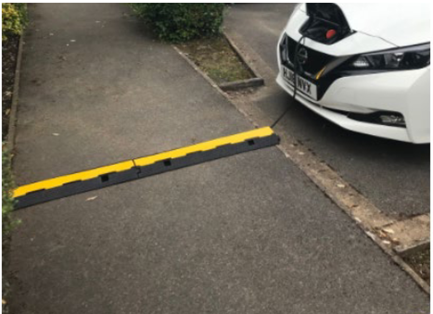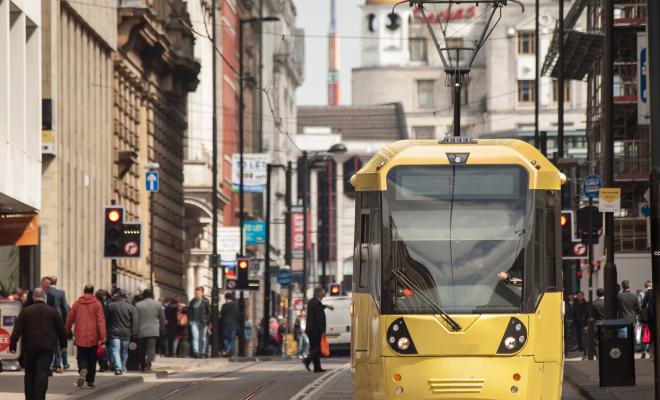20 Sep 2024
How is Action 20 tackling the climate crisis?
Widespread on-street charging is essential to give households without driveways or garages the chance to switch to electric vehicles.
In County Durham, 43% of residents live in rural areas and 40% of housing is terraced with no off-street parking. The North East has the lowest proportion of the UK’s charging points at just 3.1%. That’s why Durham County Council has placed accessible public electric charging points at the centre of its plans to promote electric vehicles. The council’s Chargepoint Delivery Plan 2021 has 5 key actions:
- Lead by example by providing charging points on council sites and transferring the council’s vehicle fleet to electric.
- Develop a network of public charging points.
- Provide charging infrastructure for the council’s fleet.
- Support appropriate private sector proposals for charging infrastructure.
- Pursue partnerships, funding and education for other electric vehicle opportunities.
The authority’s long-term goal is for every Durham resident to live within a 5-minute walk of an EV charging point. Its short-term goal is to have at least one in each of the county’s 77 wards. To do this, the council has overseen several schemes, both ongoing and completed:
- The Durham Other Chargepoints (DOC) project, backed by the UK government’s On-Street Residential Chargepoint Scheme.
- The Weardale Electric Vehicle Accelerator (WEVA) project, also backed by the On-Street Residential Chargepoint Scheme.
- The Scaling On-Street Charging Infrastructure (SOSCI) project, sponsored by Innovate UK.
- The Regional Electric Vehicle Unified Plan (REVUP) research project, funded by Innovate UK.
- The Local Electric Vehicle Infrastructure (LEVI) pilot scheme for local authorities, run by the government’s Office for Zero Emission Vehicles.
All of these schemes aim to increase on-street charging provision, especially in places overlooked by the private sector. Companies tend to focus on installing chargers in dense urban areas that already have higher electric vehicle usage, rather than on encouraging uptake in rural areas or villages and small towns.
Currently, Durham’s charging points are 22 kW and cost 35-37p per kWh to use. The average charge amount on Durham’s network is 15 kWh, costing about £4.50 for an average charging time of 1.5 to 2 hours. The Zap Map tool catalogues public charging points across the UK, enabling comparison with Durham on cost, power and charge time. There are numerous options for public charging, each varying depending on provider, location and function (for instance, charging at a motorway service station).
What impact has the project had?
More charging points
By September 2022 about 200 new charging points have been installed.
- 160 chargepoint sockets were installed via the Scaling On-Street Charging Infrastructure project (exceeding the planned 100).
- 17 chargepoint sockets and 9 chargepoint units were installed through the Weardale Electric Vehicle Accelerator project.
- 2 were installed via the Regional Electric Vehicle Unified Plan project.
- The Durham Other Chargepoints project is ongoing, with the first of 50 charging points installed in September 2022.
- 100 charging points are to be installed under the Local Electric Vehicle Infrastructure pilot scheme after Durham secured a share of an initial £10 million tranche of government funding in August 2022.
Village car clubs
Stanhope in Weardale was selected as the site for the Weardale Electric Vehicle Accelerator project, where a row of 9 charging points was installed in the village. The Stanhope charging bank helps support an already existing and highly popular car club. Residents pay £6 a month and can book an electric car for a few hours, giving them car access without the cost of maintenance or insurance.
In conjunction with Derwent Valley Car Club, the council launched a new electric vehicle hire service in April 2022. The hire service is based in Shotley Bridge, where a chargepoint was installed to support 3 electric hire vehicles.
Making charging points accessible
The council is also making sure local charging points are designed to be accessible to disabled people by hiring a consultant to oversee this work. This is particularly important as many disabled people are dependent on private vehicles as their main form of transport. In October 2021 the council invited residents to an open event on the issue where they could try using a charging point. Their feedback will be used to inform future charging point design.
Lessons learned from the Scaling On-Street Charging Infrastructure project were compiled in a series of 5 reports (available on request from [email protected]) specifically about how to make charging points accessible for all to use. In March 2022 council officers and disability groups jointly presented on this topic at an event for the Energy Saving Trust, which sought Durham’s participation as one of the few authorities actively addressing this issue.
National leader
Durham’s accomplishments have been recognised nationally and are cementing the council’s reputation as a frontrunner on electric vehicle charging points.
Completed in March 2022, the Regional Electric Vehicle Unified Plan was an 8-month-long research project for which Durham was selected by the government’s Office for Zero Emission Vehicles. It condensed the council’s learning to date into a best practice guide for local authorities (available on request from [email protected]), addressing the best methods for installing charging points and highlighting the key criteria underpinning them.
In June 2022 Durham won a prestigious Municipal Journal Award – celebrating local government employees – for Best EV Charging Project.
Finally, in August 2022 Durham was successful in its bid to the Local Electric Vehicle Infrastructure pilot. The main LEVI fund is a £450 million government programme that ultimately aims to support the mass rollout of electric vehicle infrastructure. Funds are being released gradually. The first £10 million pilot seeks to establish the best replicable models – the rest of the money will then be released to any local authority in England. Durham’s exceptional record on electric vehicle infrastructure meant it became one of only 9 councils chosen for this initial stage. Durham’s plan to trial an experimental approach called the STEP model – an ownership model whereby the chargepoint operator only owns the unit above ground, whereas the council owns all the underground works – helped it clinch the bid.
What made this work?
Broad external partnerships
Durham County Council has engaged a wide range of partners to make its charging point rollout as successful as possible and is one of 13 partners on the Scaling On-Street Charging Infrastructure project, for example. Beyond the organisers of the 3 schemes mentioned above, collaborators have included parish and town councils, the North East Combined Authority, the LA7 group of local authorities in north-east England, Durham University, Northern Powergrid and Charge My Street (a community benefit society that installs charging points).
To find the best sites for new charging points, the council is working with parish councils to identify potential locations at village halls, scout huts, community buildings and elsewhere.
Pre-planning
When the first COVID-19 lockdown occurred in March 2020, council officers used the time to plan and plot 246 prospective sites for charging points. In doing this they used Northern Powergrid’s auto-design tool, which estimated the installation cost of each specific charging point depending on grid connectivity. The cost of installation on some sites can be unjustifiably high, but by ensuring that extra potential sites are mapped in advance, another is waiting in reserve when one is ruled out.
Partnership within the council
Installing charging points needs co-operation across council teams: legal, procurement, planning, assets, highways, health and safety. To facilitate this, Durham set up an internal electric vehicle working group on the council that meets every 2-3 weeks. Durham has benefited from senior officer support, notably from the Head of Environment and the Corporate Director of Neighbourhoods and Climate Change. These secured the internal funding needed to cover the inevitable overflow costs that come with any infrastructure project.
Public communication
Key action 5 in Durham’s Chargepoint Delivery Plan has a particular focus on education, as the council strongly believes that greater knowledge among residents about the benefits of electric vehicles will help increase uptake. The council is committed to sharing the latest information and has done so via extensive outreach, spreading the word at open events hosted in communities themselves.
The council also has an electric vehicle community working group, which meets every 4-6 weeks and includes council members, members of the Scaling On-Street Charging Infrastructure initiative and residents. The ability and willingness of residents to report concerns and offer their own suggestions have made the rollout more effective. For example, one resident asked for a charging point at the Tanfield Business Centre, where they spend most of their day, and the council installed one. After making a request, Newton Aycliffe also had a charging point installed in the town’s youth and community centre.
Being unafraid to innovate and experiment
Key action 5 also outlines the council’s commitment to remain fully informed. As the market for electric vehicles grows and evolves, the council intends to closely monitor changes. Now that Durham has installed over 200 charging points, it needs to be creative about how it cracks the issue of charging points for terraced housing in order to keep up the pace.
For instance, in 2023 Durham’s electric vehicle team intends to launch a pilot with the highways team. For an initial pool of 30-35 residents, this pilot will install an innovative charging device: a “gulley” (see below), which inserts the charging cable into the pavement itself with no obstruction. The gullies will be installed in homes that don't have a garage or driveway to charge an electric vehicle. In exceptional circumstances where a gulley can't be installed, a mat solution (see below) is available as an alternative.
The pilot is targeted at the more “able-to-pay" market, although the council will partially subsidise the cost of gullies. Even months before the expected launch of the scheme, council officers are receiving weekly requests from residents to be put on the waiting list. It’s unlikely the scheme will need to be actively marketed – an indicator that Durham is succeeding in increasing local appetite for electric vehicles.
“At Durham County Council we’ve learnt a lot on the way. Small steps can lead to big changes, if you build them, they will come. Let’s get EV ready!”
Tracy Millmore, Senior Electric Vehicle Project Officer at Durham County Council.
What resources were needed?
The council won funding for charging points from multiple sources:
- Scaling On-Street Charging Infrastructure is funded by Innovate UK and has a total budget of approximately £4.13 million, of which Durham’s share is £263,638.
- £375,000 from the UK government’s On-Street Residential Chargepoint Scheme for the Durham Other Chargepoints project.
- £75,000 for the Weardale Electric Vehicle Accelerator project.
- £100,000 of top-up funding from the council’s general budget.
- £20,000 of top-up council funding channelled through the county’s 14 unique Area Action Partnerships (forums bringing together county, town and parish councillors, public sector employees and community members).
- £1.25 million from the Local Electric Vehicle Infrastructure scheme.
In 2019, Durham County Council created the role of Electric Vehicle Project Officer to oversee the implementation of the Chargepoint Delivery Plan. This role sits within the council’s Low Carbon Team and was made permanent in 2022. A further 2 members of staff, a Monitoring EV Officer and a Technical EV Officer, will be hired to support delivery into 2023 and beyond. This improved capacity should enable better data gathering and evaluation to reveal whether Durham’s work has increased local uptake of electric vehicles.
Lessons from Durham
Inequality in electric vehicle uptake and charging
Increasing accessible charging infrastructure will make the switch to electric vehicles more viable but won't lead to their widespread adoption on its own. Currently, most electric vehicle owners are relatively wealthy. Charging won't benefit individuals who can't afford an electric vehicle in the first place.
Even once lower-income households begin to take up electric vehicles, they could face charging inequalities. Using on-street public charging points is currently more expensive than private home charging (which comes through homeowners’ domestic tariff) but is the only option for some residents. As electric vehicles become more widespread, the UK government should work with local authorities to lower on-street charging costs.
As many low-income households don’t own cars, improvements to public transport will remain a key solution to help address transport inequalities, as well as cut emissions.
National policy
From 2030, sales of new petrol and diesel cars will be banned in the UK. To be prepared, local authorities need to begin planning for the wider provision of electric vehicle infrastructure.
Charger type
Councils must choose between rapid chargers, which take 30-45 minutes per charge, or fast chargers, which take 3 or 4 hours. There's a significant cost differential, as 3 fast chargers can be installed for the price of 1 rapid charger. However, residents may prefer the convenience of a rapid charger over the greater availability of fast chargers. The most suitable type of charger will vary from site to site.
Site selection
Choosing the right sites can be tricky when weighing cost considerations against prime accessible locations. Site ownership can also prove problematic, so charging points should ideally be installed on local authority land to minimise barriers, wherever possible.
Dedicated resource
Many local authorities don’t have a dedicated role overseeing charging infrastructure, instead attaching responsibilities onto existing roles in transport or parking. However, having a tailored post is beneficial, as overseeing the necessary infrastructure changes to make the UK electric vehicle ready is a unique role that brings together highways, transport, parking and more.
When the Local Electric Vehicle Infrastructure fund opens up to wider applications, local authorities will be able to use allocated money to cover staff costs. Others will therefore be able to follow Durham’s approach and hire staff whose remit exclusively covers electric vehicle infrastructure.
“Having the resources to be solely focused on EV charging has made the difference here. Going forward, having a proper EV Team will bring things to life. Yes, we’ve achieved a lot in 3 years, and people say we’ve made a splash, but it really has been a gradual process. A chargepoint doesn’t go in overnight. We have installed our chargepoints in batches and with each batch there are new lessons learned and a story to tell. Each batch will have a unique obstacle, but overcoming it helps with the next batch and makes installation easier. Continuing to communicate and build relationships with our Distribution Network Operator, our chargepoint operators, with the planning, parking and transport teams, is the best way to get chargepoints in the ground and get them working.
Tracy Millmore, Senior Electric Vehicle Project Officer at Durham County Council.
Useful information
For further information, please contact Tracy Millmore.
Related projects
We've found some examples of other council activity on this topic.
- Portsmouth City Council has invested in innovative charging infrastructure to encourage electric vehicle usage.
- Falkirk Council is home to the largest electric vehicle charging station in Scotland.
- Gwynedd Council is consulting residents on the best locations for charging points.
Friends of the Earth's view
Durham County Council is taking important steps towards facilitating the switch to electric vehicles by installing charging points, especially in rural areas which are often lacking in charging infrastructure.
Councils should also be rapidly switching their own fleets to electric (Action 25 of the Climate Action Plan). But helping to facilitate the switch to electric vehicles is just one aspect of cutting emissions from transport, and councils should also be prioritising investment in cycling, walking and public transport (Action 21).
Friends of the Earth is showcasing specific examples of good practice in tackling climate change, but that doesn’t mean we endorse everything that a council is doing.
This case study was produced by Ashden and Friends of the Earth. It was originally published in February 2022 and was last updated in December 2022. Any references to national policy in this case study relate to policy under the previous government and reflect the policy context in which the council was operating at the time.






